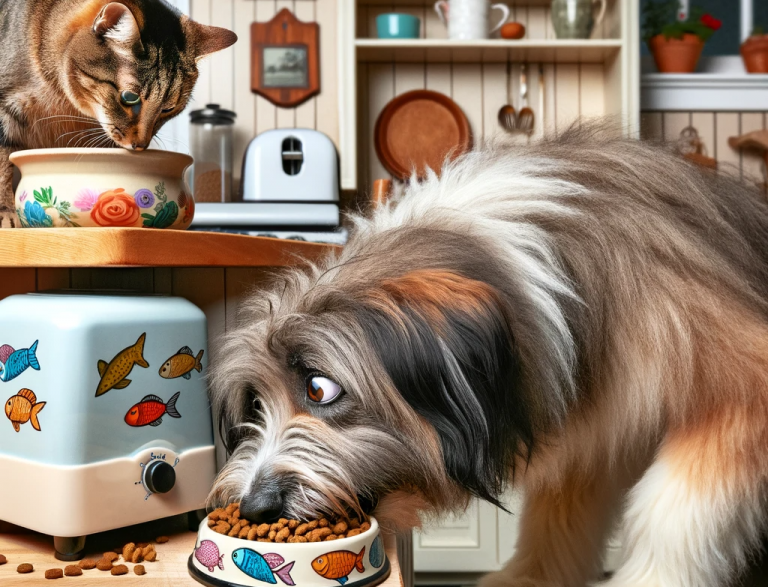How to make a Dog throw up – saving your dog in an emergency

We all know the situation.
Our normally well-behaved dog suddenly uses the opportunity when you are looking away to snack on something they shouldn’t have. If we are too slow to react, they swallow it.
Now, what if it was something bad they shouldn’t have eaten? When should we make them vomit and when can it cause more harm than good?
That is what we are going to explore in this article.
TL;DR: How to make a dog throw up
Making your dog throw up can be dangerous if they swallowed:
– sharp objects
– chemicals like bleach, drain cleaner or certain drugs
Things to make them throw up:
– Hydrogen Peroxide (ONLY 3% solution)
– Saltwater
– Mustard water
– Activated Charcoal
– egg whites
Often, a dog will throw up by themselves if they eat something bad. But not always. Let’s get into the nitty gritty of when to help our little friends throw up and when not to.
When should we make our dog throw up
Making a dog throw up can be dangerous or is not recommended depending on the situation.
It should only be done in emergencies as visiting a Vet or animal clinic is often the better option.
Depending on what our dog swallowed, it might even harm them more.
When is throwing up dangerous for dogs
In some cases, it can cause more harm than good to have a dog vomit.
If your dog did one of the following things you should be careful and immediately contact a Vet
swallowed something sharp
If your dog swallowed something sharp like a razor, making them vomit would only make it worse.
Immediately contact your vet or bring them to a pet clinic. Time is of the essence!
swallowed something acidic or corrosive
If they swallowed something Acidic or Corrosive like a pipe cleaner, having them throw up may also cause more harm than good. Especially to their throat and windpipe.
Bring them to a clinic immediately.
Feeding them activated charcoal can help in binding some of the toxins and acids but it is no solution, just a bit of help.
having Seizures
If your little pup has seizures you should not make them vomit.
Vomiting and seizures are a bad combination which can block their windpipe and suffocate them.
Being Comatoes
The same as with a seizure, a comatose dog should not be brought to vomit. Their muscles are too lax which can cause vomit to block their windpipes or get into the lungs.
recovering from abdominal surgery or treatments
If your dog is recovering from abdominal surgery it is not recommended to make them vomit. Not yet healed cuts and wounds may break open again and have them suffer heavy internal bleeding.
how to make them throw up
Making a dog throw up should be done if they ate something toxic or something like medicine.
Especially if they just swallowed something bad, it might save our furry family members from the bad effects of it.
Generally, I would always recommend calling a Vet or the Pet Poisoning hotline to get an expert opinion. If that is not an option here are the ways to make your dog safely throw up:
Hydrogen Peroxide (3% solution)
Feeding your dog Hydrogen Peroxide is one of the most effective ways to make your dog throw up.
Pay attention to the ratio, you only want to give them a 3% solution, as higher concentrations may cause more harm and acidic burns for your dog. If you don’t have a 3% solution don’t try to water it down yourself, as this is hard to properly do.
Instead, try something different from this list
Saltwater
Mix one teaspoon (5-6 grams) of salt into warm water until it is completely dissolved and feed it to your dog.
This saltwater will cause the gag reflex and make them vomit.
Mustard Water
Mix one tablespoon (14 grams) of mustard with warm water until dissolved.
Feeding this to your dog will trigger their gag reflex.
Try to pay attention to not use any hot mustards, as this may cause pain to your furry friend.
Egg Whites
Mix two egg whites with some warm water. Only use fresh eggs.
Feeding this to your dog will also trigger the gag reflex.
Activated Charcoal
Activated Charcoal is more of a binding agent than used to vomit. It can bind toxic substances and keep them from getting into the bloodstream.
If you have activated charcoal capsules, try to get the activated charcoal out because they take some time to dissolve in the stomach.
Large amounts of Water
Feeding your dog large amounts of water can help dilute any toxic substances they ingested and even make them throw up
Ipecac Syrup
Only give your dog Ipecac Syrup if your Veterinary suggested this to you.
The common ratio is one tablespoon (5-6 grams) per 22 pounds (10 Kg) of weight.
But three tablespoons MAX
Toxic and Bad Food for Dogs

While most dogs are very interested in the food we eat, it can be very bad for our little friends.
Here is a list of foods that are toxic to humans best friend, which should be avoided
Alcohol
Dogs can’t process alcohol like humans. Not only can they get drunk and hurt themselves, but it also harms them in other ways like
- low body temperature,
- dangerously low blood sugar,
- liver damage,
- seizures, or
- coma
Bones
Everyone knows that bones are good for dogs, right?
No.
Some bones.
There are a few bones that are not only bad for dogs but can even be dangerous to consume.
For example, cooked bones become brittle and can splinter and puncture their mouth, throat and stomach.
Here is a list of Bones that should be avoided:
- Cooked Bones
- Chicken & Turkey Bones
- Pork bones
- Goose bones
- T-Bones
Blue Cheese
Blue cheese contains substances that are bad for dogs. Especially a substance called roquefortine C, which is made from the blue fungus that gives this cheese its characteristic colour and taste.
If your dog consumes too much, it can cause muscle tremors and seizures that hold for days.
Chocolate
Especially around Christmas and Easter, chocolate poisoning cases skyrocket.
Due to chocolate containing something called theobromine, they are not safe for dogs (and most other animals). While all chocolate is poisonous for dogs, the darker the chocolate the more theobromine is contained.
So try to keep your chocolate away from the floor or low tables, especially in the coming Christmas time.
Grapes & Raisins
Grapes, Raisins, currants and sultanas are all toxic for dogs. Especially the dried versions of the fruits.
While some dogs have eaten great quantities with nothing happening to them, this is not the norm. A lot of problems can be caused by consuming these, especially if fed regularly.
Common symptoms are:
- Stomach problems
- kidney failure
- increased thirst
even in smaller amounts, these symptoms can appear.
Macadamia nuts
It’s not completely clear why macadamia nuts cause harm to dogs, but we do know that they do.
Macadamia Nuts can cause weakness, pain and stiffness in the legs.
In bigger doses, it can also cause vomiting, lethargy, seizures and fever.
Mouldy foods
Not only humans shouldn’t eat mouldy food.
While some people think dogs can eat anything, that is not true.
Mould can contain a lot of different toxins and cause serious harm when eaten. It can also cause allergic reactions and have long-lasting effects.
Onions, Garlic, Leeks, shallots & Chives
Onions, garlic, leeks, shallots and chives are part of the Allium plant family. They all contain a substance which damages red blood cells in dogs. This can cause a life-threatening condition called anaemia.
Especially dangerous can be that signs take a few days to show up which makes it harder to spot the cause of the problems.
Symptoms of this can be:
- sleepiness
- dullness
- stomach problems
- rapid breathing
- discoloured urine
Raw Dough
Raw dough, especially the dough for bread contains yeast.
Yeast likes to rise, especially in the moist and warm environment of a stomach.
Consuming yeast can cause vomiting, bloat and stomach twists. In bad cases, the stomach could even burst.
Another problem can be caused when the yeast is producing alcohol, which is also toxic to dogs.
Sugar & Sweets
Some dogs love sugary things just like we do. But too much sugar intake can cause a lot of problems for our pups.
By eating too much sugar, dogs can develop pancreatitis which can cause them:
- loss of appetite
- vomiting
- diarrhoea
- lethargy
- organ failure
Xylitol sweetener
Xylitol is commonly used as a sugar replacement. It’s especially common in the US but also in Britain and other parts of Europe.
It can cause
- very low blood sugar (quickly)
- sudden collapse and lethargy
- liver failure
Final Thoughts
All in all, I would always recommend first consulting a Veterinary or Pet Poison Control if your dog ate something bad.
Only when that is not possible should you apply measures from this list.
I hope this helps you in keeping your little pups safe, and happy cuddling!


